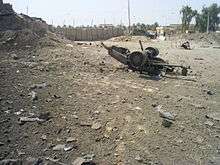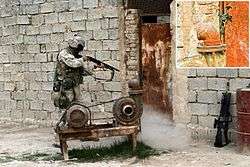Al-Karmah
Al-Karmah, also sometimes transliterated as Karma, Karmah, or Garma (Iraqi Arabic: الگرمة), is a city in central Iraq, 16 km northeast of Fallujah in the province of Al Anbar.
Al Karmah الگرمة | |
|---|---|
| Coordinates: 33°23′59″N 43°54′32″E | |
| Country | Iraq |
| Governorate | Al Anbar |
| Population (2013) | |
| • Total | 95,000 |
| Time zone | UTC+3 (GMT+3) |
| Postal code | 31013 |
Invasion of Iraq
For most of 2005 to 2007, Al-Karmah was considered the most violent city in Iraq. Unlike neighboring Fallujah, it has no surrounding wall, so anti-American insurgents could move freely in and out of it. Attacks by mortar and small arms occurred almost daily on coalition patrols, convoys, and the FOBs (Forward Operating Bases) of Camp Donnica, OP (Observations Post) 2, OP 2A and OP 3.
During the Second Battle of Fallujah, residents of Karma funneled weapons and medical aid into the besieged city, proudly proclaiming their allegiance to the insurgency.[1] The city's cement factory was shelled by US artillery that month as the factory was being used as a rebel position.[2]
During 2005, a massive vehicle-borne IED was driven into Observation Post 2 Alpha, injuring 4 U.S. Marines from 2nd Battalion, 2nd Marines, Fox Company 3rd Platoon, destroying two ISO containers filled with MREs and bottled water, and damaging the Hesco barriers and concertina lines along the western wall. In later raids on houses in the area, a video was found of the preparation and execution of the attack. It resulted in more barricades and new speed bumps being placed in and around the roads leading to OP-2A and the other observation posts, and the reinstallation of the ground-level M240G.

.jpg)
In early September 2005, Karmah was the site of the establishment of the New Iraqi Army's operations in the area, with the participation of the 1st Battalion, 4th Brigade, 1st Division operating at Observation Post 3 and Camp Donnica.[3] On July 8 of that year, an IED struck a US convoy, followed by insurgent mortar attacks on the damaged convoy, resulting in "many" casualties.

On October 6, 2005 a Marine convoy from 2nd Battalion, 2nd Marines, Golf Company, Weapons platoon was struck by an IED, killing four Marines and injuring three. In November 2005, the first Iraqi Police station was established in Karmah. It was met with violence from the local population, who strongly opposed any coalition forces.[3] The station was attacked by insurgents, causing the Iraqi Police to abandon the post. The station became an observation post for the Marines of 2nd Battalion, 2nd Marines, Golf Company, Weapons platoon. On November 19, 2005, an insurgent sniper shot and killed a Marine Lance Corporal standing post on the roof of the station. On December 24, 2005 the Marines of weapons platoon faced a substantial insurgent attack where part of the compound was destroyed from a hand-placed explosive device. A video of the attack was recovered from a dead insurgent and can be seen on the Internet. During the attack, a squad of Marines held off the insurgents for over 10 minutes until a vehicle-mounted Quick Reaction Force (QRF) arrived from nearby OP3.
In 2006, the city saw greater presences of Iraqi Army and Iraqi Police. Violence continued at a steady rate, with multiple small-arms ambushes on foot and vehicle patrols, as well as IED attacks frequently utilizing combined arms and mortar attacks on the blast sites, causing multiple American and Iraqi Army casualties.
On May 11, 2006 seven U.S. service members died in Iraq, including four Marines who drowned when their tank rolled off a bridge near Al-Karmah.[4]
In late 2006, during a sniper attack in Al-Karmah, a series of iconic photographs were taken by New York Times photographer João Silva and reporter C. J. Chivers. The attack involved Weapons Company, 2nd Battalion 8th Marines and Sgt. Jesse E. Leach, who became known as "The Iron Sergeant".[5][6]
On February 7, 2007, a US Marine CH-46E Sea Knight from HMM-364 was shot down by a shoulder-fired missile, killing all seven aboard. Three of the US Army Engineers of A Co. 321st Engineers sent to secure the wreckage were also killed by an IED.[7] 13 days later, US forces raided a car bomb factory, where they discovered five vehicles, three 55-gallon barrels of chlorine, three barrels of nitroglycerine, artillery rounds and bombs. One man was detained, and the US stated that the factory was likely run by al-Qaeda.[8] On March 17, insurgents attacked an army foot patrol, killing two. Eleven days later, a National Guard humvee was reported destroyed, with insurgents claiming all aboard were killed. Two days later, a less successful bomb destroyed a humvee, with no casualties. On April 2, another humvee was reported destroyed, with all aboard once again reported killed.[9]
On August 31, 2007, a safe house wired with explosives was destroyed in the city. It was believed to have been an arms cache and a launching point for mortars that had targeted the police station in Karma.[10]
On May 2, 2008 four Marines were killed in a roadside blast in Lahib, a farming village just east of Karmah.
On June 26, 2008, three Marines from 2nd Battalion 3rd Marines (including the battalion's commanding officer), 20 Iraqi sheiks, the mayor of Karmah, and two interpreters were killed when a suicide bomber dressed as an Iraqi Policeman detonated an explosive vest at a meeting of tribal sheiks.[11][12] The attack's aftermath was filmed by photojournalist Zoriah Miller.[13]
On February 8, 2009, local police chief Lieutenant Col. Abd Al Salam was nearly killed by a 300-pound IED.[14]
ISIL control and recapture
In 2014, Karmah and the nearby city of Fallujah came under ISIL control. The Iraqi army and its allies had clashed with ISIL in Karmah for months, mainly during the Al-Karmah offensive in April and May 2015, and during the Anbar offensive of February 2016. On 23 May 2016 it was reported that the city was recaptured by Shiite militias of PMF during Operation Breaking Terrorism.[15]
References
- "'Every town will become a Falluja'". Financial Times. Retrieved 1 May 2016.
- James Paul - Global Policy Forum. "Allawi Declares State of Emergency". Retrieved 1 May 2016.
- Michael Fumento. "Michael Fumento: Back to Fallujah". Retrieved 1 May 2016.
- https://www.globalsecurity.org/military/ops/iraq_casualties_may06.htm
- Chivers, C.J. "Courage, Recognized: The Infantry and Joao Silva".
- Kristopher Battles. "Sketchpad Warrior : The Iron Sergeant". Retrieved 1 May 2016.
- "Light Warfare". Forbes. April 23, 2007. Archived from the original on February 26, 2009. Retrieved April 14, 2007.
- "U.S. says Iraq chlorine bomb factory was al Qaeda's". Reuters. February 24, 2007.
- Defiant Fallujah Remains Hot As Mujahideen Log Near Daily Attacks Against The Occupiers Archived 2011-07-19 at the Wayback Machine
- Multi-National Force - Iraq - Karmah terrorist safe house destroyed following Iraqi Scout, U.S. Special Operations Forces raid
- "Suicide bomber kills 3 Hawaii Marines - Battalion commander among suicide bomber's victims". 2008-06-28. Retrieved 2008-06-28.
- "United States Department of Defense". Retrieved 1 May 2016.
- "ZORIAH - A PHOTOJOURNALIST AND WAR PHOTOGRAPHER'S BLOG". ZORIAH - A PHOTOJOURNALIST AND WAR PHOTOGRAPHER'S BLOG. Retrieved 1 May 2016.
- "300 pound IED does not deter Iraqi police chief". Archived from the original on 2009-03-14. Retrieved 2010-02-09.
- Iraqi military claims advances in Islamic State-held Fallujah, Washington Post
| Wikimedia Commons has media related to Al-Karmah. |